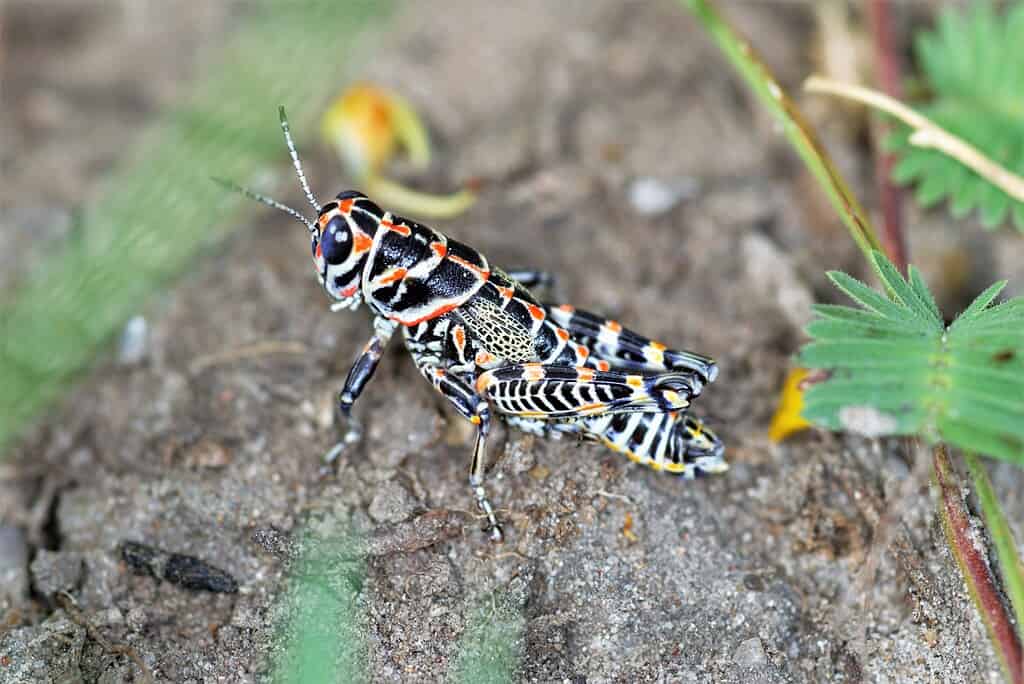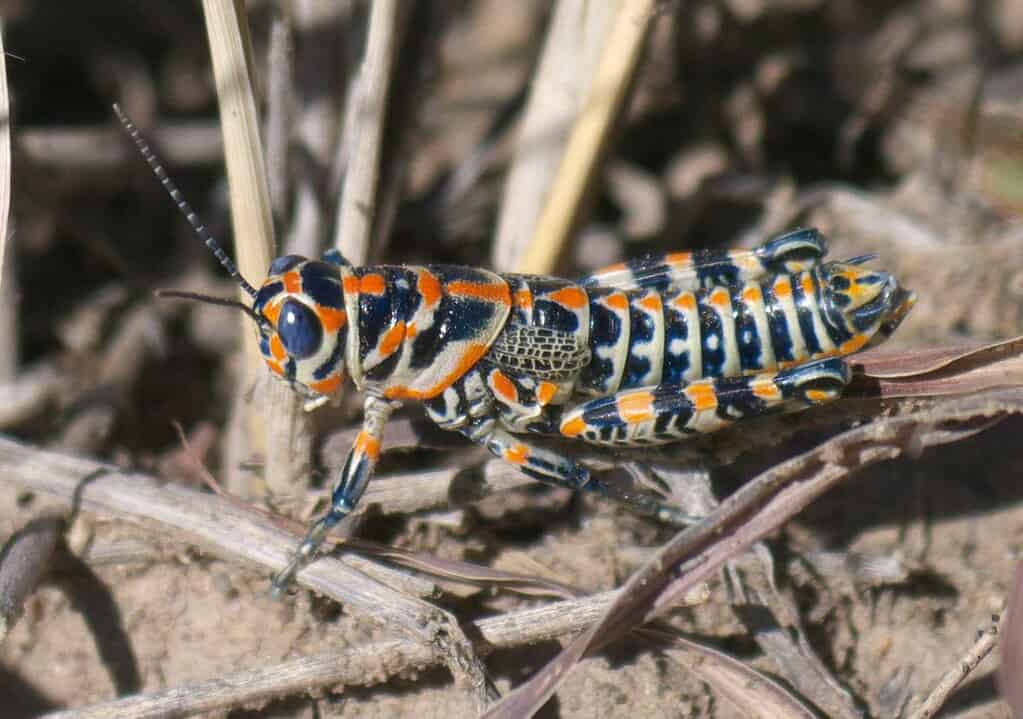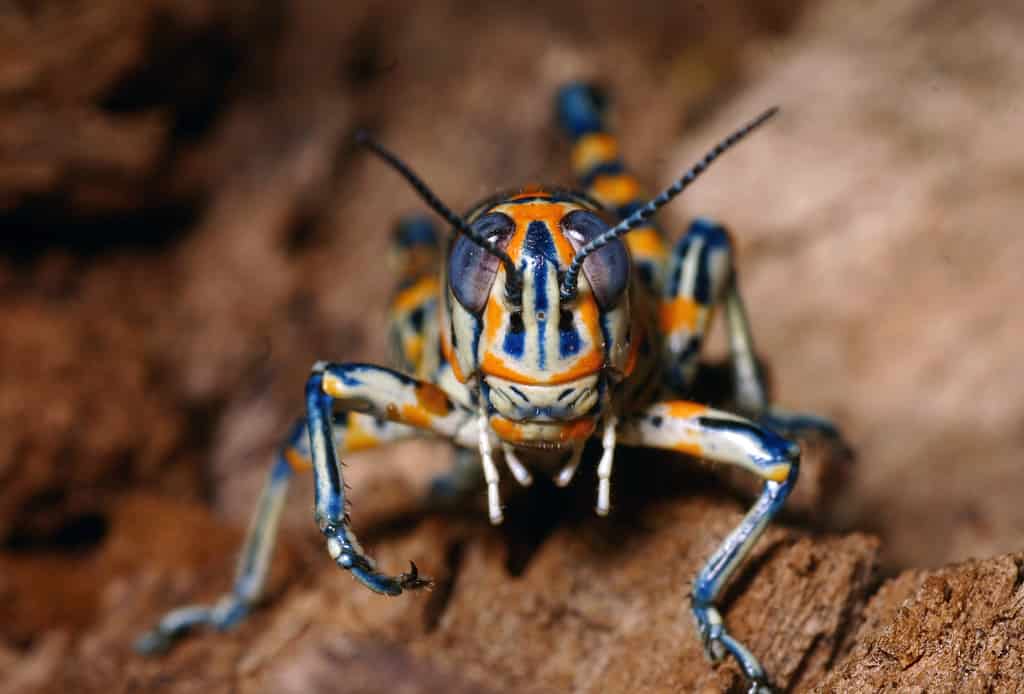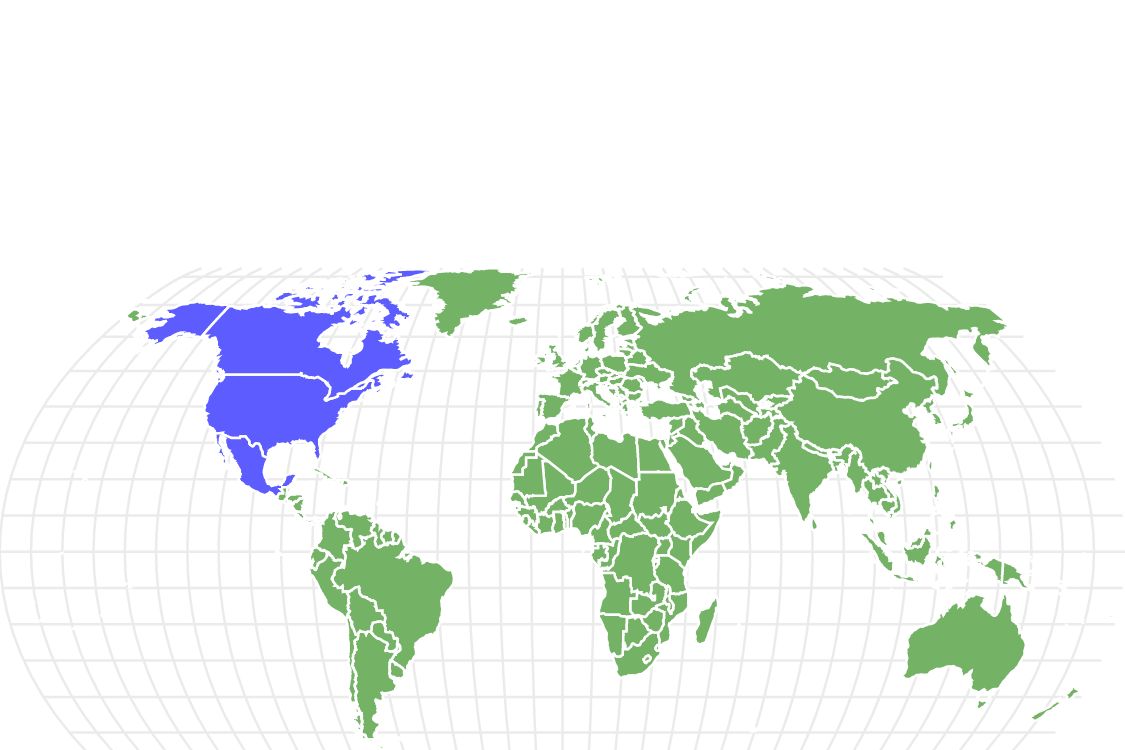Rainbow Grasshopper (Dactylotum bicolor)
Dactylotum bicolor
Rainbow grasshoppers use their bright coloration to convince predators that they are poisonous!
Advertisement
Rainbow Grasshopper (Dactylotum bicolor) Scientific Classification
- Kingdom
- Animalia
- Phylum
- Arthropoda
- Class
- Insecta
- Order
- Orthoptera
- Family
- Acrididae
- Genus
- Dactylotum
- Scientific Name
- Dactylotum bicolor
Read our Complete Guide to Classification of Animals.
Rainbow Grasshopper (Dactylotum bicolor) Conservation Status
Rainbow Grasshopper (Dactylotum bicolor) Facts
- Name Of Young
- Nymph
- Group Behavior
- Solitary except during mating season
- Fun Fact
- Rainbow grasshoppers use their bright coloration to convince predators that they are poisonous!
- Biggest Threat
- Habitat loss
- Most Distinctive Feature
- Bright coloration
- Other Name(s)
- Painted grasshopper, barber pole grasshopper, pictured grasshopper, Uncle Sam grasshopper
- Predators
- Small mammals, birds, reptiles, amphibians, other insects
- Diet
- Herbivore
- Lifestyle
- Diurnal
- Favorite Food
- Various plants including forbs and grasses
- Special Features
- Enlarged hind legs, no wings
- Number Of Species
- 1
- Location
- North America
- Slogan
- They have strikingly bright colors
- Group
- Cloud
Rainbow Grasshopper (Dactylotum bicolor) Physical Characteristics
- Color
- Yellow
- Red
- Black
- White
- Orange
- Skin Type
- Exoskeleton
- Lifespan
- Up to 1 year
- Venomous
- No
- Aggression
- Low
View all of the Rainbow Grasshopper (Dactylotum bicolor) images!
The rainbow grasshopper is currently the only species within the genus Dactylotum. It is endemic to North America, ranging from southern Canada to northern Mexico. Its arresting coloration consists of reddish-orange, yellow, white, and black markings. This herbivore is typically solitary except when mating and is not generally considered a pest. It is also nonpoisonous despite its bright colors.
Rainbow Grasshopper Species, Types, and Scientific Name
The scientific name for the rainbow grasshopper is Dactylotum bicolor. The term “bicolor” refers to its colorful hues. Alternate names for this species include the painted grasshopper, barber pole grasshopper, pictured grasshopper, and Uncle Sam grasshopper. The German entomologist Toussaint de Charpentier initially described it in 1843. The species subdivides into three subspecies:
- Dactylotum bicolor bicolor
- Dactylotum bicolor pictum
- Dactylotum bicolor variegatum
This species is currently the only member of the genus Dactylotum. It also belongs to the family Acrididae (short-horned or true grasshoppers, including locusts). Acrididae contains over 10,000 species of grasshoppers and lies within the order Orthoptera (grasshoppers, locusts, crickets, and katydids). It further belongs to the class Insecta (insects) and the phylum Arthropoda (invertebrate animals with an exoskeleton).
Appearance: How to Identify the Rainbow Grasshopper

The rainbow grasshopper gets its name from its striking color pattern featuring reddish-orange, yellow, white, and black markings.
©Ken Beard/Shutterstock.com
The rainbow grasshopper lives up to its name with a striking color pattern featuring reddish-orange, yellow, white, and black markings. Both its prothorax and its wing pads are pale green. Its coloration may vary across regions according to subspecies. Unlike some other species of grasshoppers, it lacks wings and therefore cannot fly. Like all insects, however, it has six jointed legs. Although all six are useful for walking, the front two are also capable of holding food while the muscular rear pair is useful for jumping.
In terms of size, these grasshoppers are sexually dimorphic. Males average 0.8 inches in length while females grow larger with an average length of 1.4 inches.
Habitat: Where to Find the Rainbow Grasshopper
The rainbow grasshopper has a large endemic range that includes Alaska, southern Canada, the western Great Plains of the United States, and northern Mexico. In Canada, it inhabits the southwestern provinces of British Columbia, Alberta, and Saskatchewan. In the United States, it inhabits Alaska, Arizona, Arkansas, California, Colorado, Idaho, Montana, Nebraska, Nevada, New Mexico, Oklahoma, Oregon, Texas, Utah, Washington, and Wyoming.
This species’ preferred habitats include shortgrass prairie, desert grasslands, alfalfa fields, and areas with sparse vegetation. As a solitary insect, it comes together with others of its species primarily to mate.
Due to stable populations and a large range, the IUCN does not currently include this species on its Red List of Threatened Species.
Evolution and History

Unlike some other species of grasshoppers, the rainbow grasshopper lacks wings and cannot fly.
©xpda, CC BY-SA 4.0, via Wikimedia Commons – License
The order Orthoptera (grasshoppers, locusts, crickets, and katydids) originated about 350 to 300 million years ago during the Carboniferous Period. During the Permian Period (about 300 to 250 MYA), it divided into two suborders: the Ensifera (crickets and katydids) and the Caelifera (grasshoppers and locusts). Within Caelifera, the family Acrididae (true grasshoppers) originated about 65 to 59.3 MYA during the Cenozoic Period in the Paleocene Epoch. Grasshoppers are the most recent orthopteran superfamily and evolved along with grasslands.
The worldwide dispersion of grasshoppers likely came about because they first appeared before South America and Africa separated. Scientists debate whether the common ancestor of modern grasshoppers came from South America or Africa, though there is evidence for the former.
Diet: What Do Rainbow Grasshoppers Eat?

The rainbow grasshopper’s front legs are capable of holding food.
©Michael Benard/Shutterstock.com
Rainbow grasshoppers are herbivores in both their nymph and adult stages. They have a number of predators, though they use aposematism (warning coloration) to advertise their toxicity and deter potential predators. Despite this, they are not poisonous.
What Does the Rainbow Grasshopper Eat?
These insects are polyphagous, though they primarily feed on low-growing forbs (herbaceous flowering plants) as well as some types of grasses. Unlike some other species of grasshoppers and locusts, they generally avoid feeding on crops. Nymphs born in Arizona and New Mexico feed solely on Wright’s false willow (Baccharis wrightii), thermoregulating by positioning themselves either in the sunlight or shade depending on the time of day.
What Eats the Rainbow Grasshopper?
This species falls prey to the usual range of grasshopper predators including small mammals like foxes, possums, raccoons, shrews, bats, and rodents. They are also the targets of reptiles and amphibians like snakes, lizards, frogs, toads, and newts. Various insects like spiders, beetles, crickets, and bee flies may prey on adults as well as eggs and nymphs. Birds like blackbirds and blue jays also go after grasshoppers, though most birds seem to avoid this particular species as do some members of the above groups.
Prevention: How to Get Rid of Rainbow Grasshoppers
Unlike many species of grasshoppers, the rainbow grasshopper is not generally considered a pest. For one thing, it rarely eats crops, which is the main reason insects like these come into conflict with humans. For another thing, it is solitary by nature and therefore does not make a nuisance of itself by gathering in large groups. In addition to this, it is not poisonous or dangerous to handle. Humans coming into contact with rainbow grasshoppers should be able to safely relocate them or else simply enjoy watching them in their natural habitat.
Related Animals:
View all 114 animals that start with RRainbow Grasshopper (Dactylotum bicolor) FAQs (Frequently Asked Questions)
Are rainbow grasshoppers dangerous?
This species is not dangerous to either humans or other animals. However, it uses aposematism to deter potential predators by appearing to be poisonous.
How many legs does the rainbow grasshopper have?
Like all insects, this species has six jointed legs. The front two are useful for holding food while the back two are useful for jumping.
How do you identify rainbow grasshoppers?
This species is colorful with reddish-orange, yellow, white, and black markings. Its coloration may vary by region. It has six legs but lacks wings and the power of flight. Males average 0.8 inches in length while females average 1.4 inches.
How do you get rid of rainbow grasshoppers?
Although many species of grasshoppers are pests, rainbow grasshoppers are harmless to both humans and crops. They are also solitary and therefore do not gather in large numbers.
Where are rainbow grasshoppers found?
This species has a large range from southern Canada to northern Mexico. In the United States, it inhabits mostly western states.
Are rainbow grasshoppers endangered?
The IUCN does not currently include this species on its Red List.
Thank you for reading! Have some feedback for us? Contact the AZ Animals editorial team.
Sources
- Bug Guide, Available here: https://bugguide.net/node/view/31526
- Insect Identification, Available here: https://www.insectidentification.org/insect-description.php?identification=Painted-Grasshopper
- Our Breathing Planet, Available here: https://www.ourbreathingplanet.com/rainbow-grasshopper/
- Entomology Today, Available here: https://entomologytoday.org/2015/04/08/the-origin-of-grasshoppers-katydids-and-crickets-a-new-study-resolves-the-evolutionary-tree-of-the-orthoptera/
- Hojun Song, Ricardo Mariño-Pérez, Derek A Woller, Maria Marta Cigliano, Evolution, Diversification, and Biogeography of Grasshoppers (Orthoptera: Acrididae), Insect Systematics and Diversity, Volume 2, Issue 4, July 2018, 3, Available here: https://academic.oup.com/isd/article/2/4/3/5052737

















